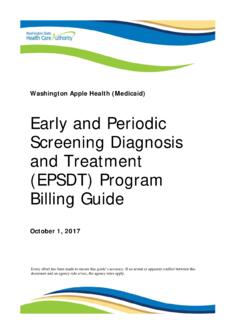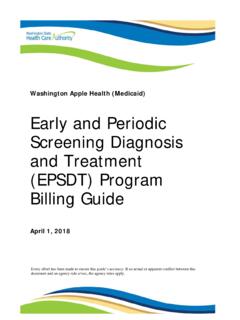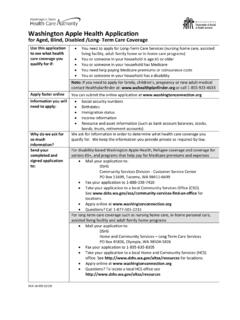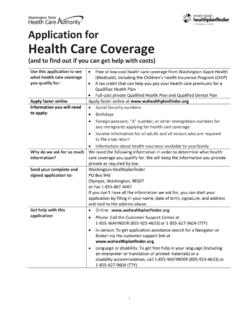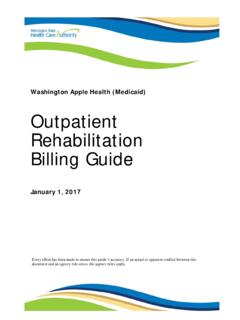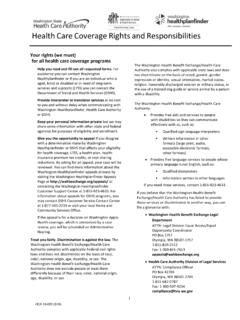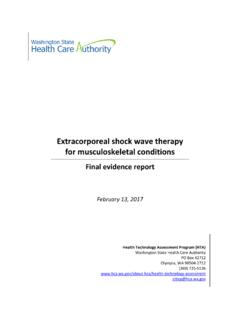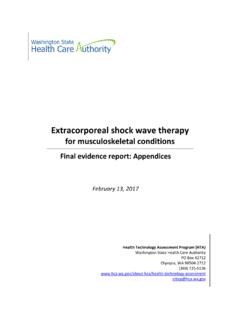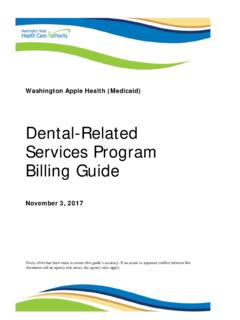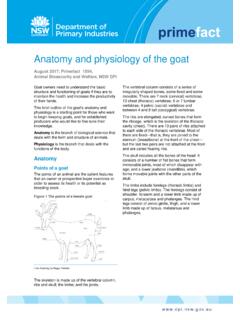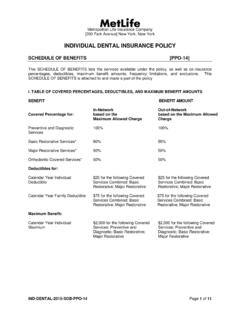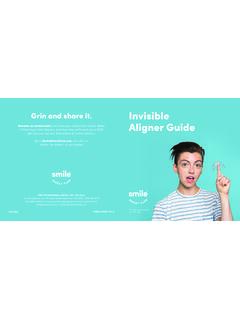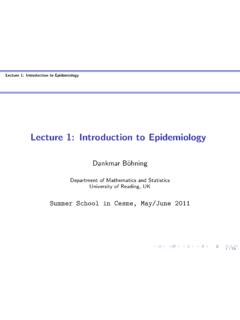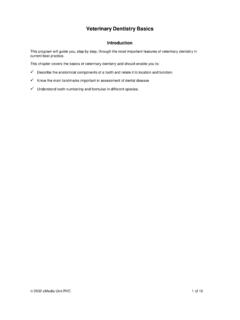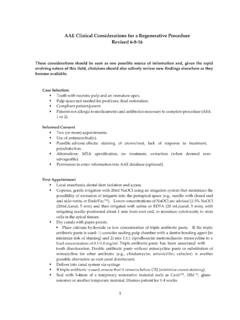Transcription of Orthodontic information for authorizations - Wa
1 Page 1 of 5 HCA 13-666 (1/22) Orthodontic information Orthodontic AuthorizationsIGeneral informationProvider name Performing provider number Billing provider numberPatient s Last name Patient s first name Patient s middle initialPatient s birth date Patient s age (years/months) Client's ID II Orthodontic treatment requested and diagnostic informationPlease check the box for the requested Orthodontic treatment below. Comprehensive treatment Limited treatment Case study only (ETR Requests only) Fixed appliance therapy Extension request (if checked, indicate months required to complete treatment): Transfer case (if checked, indicate months required to complete treatment): Tentative treatment plan:Functional concerns:Will the client require orthognathic surgery?
2 Yes NoHas the client seen a general dentist in the last 12 months? Yes NoStage of dentition: Primary Adolescent Mixed/TransitionalAnterior teethOverjet mmOverbite mmOpen bite mmMidline mmCrossbite Indicate maxillary teeth involvedPosterior teethAngle ClassificationSkeletal classification (check one) Class I Class II Class IIID ental classification (check one)Left Right Class I Class I E to E E to E Class II Class II Class III Class IIIC rossbite Indicate maxillary teeth involvedAnterior Crowding (Approximate)MAX mmMAND mmSpacing (Approximate)MAX mmMAND mmOral hygieneGood Fair PoorPage 2 of 5 Missing teeth Tooth/location Ectopic eruption as defined in the HLD scoring instructions on page 5.
3 (Numbers of teeth excluding third molar(s) Missing (indicate teeth) Impacted (indicate teeth. Numbers of teeth excluding third molar(s)) Ankylosed (indicate teeth) Supernumerary (indicate location): Client s chief complaintHabitsMusculature: tone and functionSymmetry of archesTemporomandibular dysfunctionRestoration or caries problemsOther medical or dental problems.)
4 Page 3 of 5 III Overbite, crossbite or overjet information . Please check a box for each condition that applies . 1. Deep impinging overbite: Indicate an X on the scoresheet when lower incisors are destroying the soft tissue of the palate. A clear, non-blurry photograph of the palate demonstrating soft tissue destruction must be submitted. Only the maxillary central incisors can be utilized for the measurement of overbite. Deep impinging overbites without visible soft tissue destruction will not be considered medically necessary 2. Crossbite of individual anterior teeth: Indicate an X on the scoresheet when destruction of the soft tissue is present. Recession of labial gingival tissue due to crossbite must be greater than 1mm and the recession must not be due to the lower crowding but directly related to the anterior crossbite.
5 3. Overjet 9mm or greater: Indicate an X on the scoresheet if the client has an overjet of 9mm or greater, or the reverse overjet (mandibular protrusion) is or greater. If this is applicable, provide a color photo using either a probe or ruler to demonstrate the condition. Photo should show the horizontal distance from the labial surface of maxillary central incisor to a corresponding reference point directly beneath on a mandibular incisor. Distance between points should not represent a diagonal distance around the arch. Ruler or probe should be oriented in the horizontal plane of space with tip visible at the labial surface of lower incisoror with tip visible at the labial surface upper incisor in the case of negative overjet. If the reverse overjet is not greater than , score under Part IV, #3.
6 Please refer to HLD instructions on page 5 for proper measuring technique for overjet. 4. NEGATIVE OJ RELATIVE TO A SKELETAL CLASS III: Indicate an X on the score sheet if when there is a negative overjet relative to a skeletal class III, a recent cephalometric film must be submitted to confirm this Negative Overjet must be determined in mm s and based on relative position of the incisal edge of the lower central incisor and the labial surface of the upper central incisor. Measurement must be reckoned in the horizontal plane of space. A zero mm OJ will not be considered a negative OJ measurement. IV Handicapping Labiolingual Deviation Index (HLD).See instructions regarding scoring on page 5. 1.
7 Overjet in mm. 2. Overbite in mm. 3. Mandibular protrusion. 5 = 4. Open bite in mm. 4 = If both anterior crowding and ectopic eruptions are presentin the anterior portion of the mouth, score only the most severe condition. Do not score both Ectopic eruption: Count each tooth, excluding third molars 3 = 6. Anterior crowding: Anterior arch length insufficiency must be equal or greater than ; Score 5 points for the maxillary teeth if applicable, 5 points for the mandibular teeth if applicable and 10 points if both arches exhibit anterior crowding of or greater.
8 5 = 7. Posterior unilateral crossbite: This condition involves two or more adjacent maxillary teeth, one of which must be a permanent molar. The crossbite must be one in which the maxillary posterior teeth involved may be both palatal or both completely buccal in relation to the mandibular posterior teeth. The presence of posterior unilateral crossbite is indicated by a score of 4 on the scoresheet. If both left and right posterior crossbite are present, score 4 for each side. Edge to edge relationships will not be scored. Provider s estimated total hld score (required) PLEASE NOTE: The HLD scoring is a guideline for your use and reference, and will be confirmed by our consultants.
9 You will still be required to send all required information referred to in Billing Instruction and WAC. The department will make the final decision regarding medical necessity and scoring. This information may not be used to predetermine coverage in order to charge the 4 of 5 VSignatureExamination completed by (print name) DateI certify that I am the performing provider and that the medical necessity information is true, accurate, and complete, to the best of my knowledge. I understand that any falsification, omission, or concealment of material fact in those sections may subject me to civil or criminal liability. To sign this form, save it to your desktop first. Performing provider signature DatePrint name (include credentials)Page 5 of 5 Part IV instructions: Handicapping labiolingual index scoring for severe malocclusionThe intent of the HLD Index is to measure the presence or absence, and the degree, of the handicap caused by the components of the Index, and not to diagnose malocclusion.
10 All measurements are made with a ruler scaled in millimeters or a periodontal probe scaled in millimeters. Absence of any conditions must be recorded by entering O (refer to scoresheet).The following information should help clarify the categories on the HLD Index:1. Overjet in millimeters: This is recorded with the patient s teeth in centric occlusion and measured from the labial portion of the lower incisors to the labial of the upper central incisors. The measurement may apply to a protruding single tooth as well as to the whole arch. Horizontal distance from upper central incisor to labial surface of corresponding point on lower incisor directly behind the reference point on the upper central incisor. Distance between reference points should not represent a diagonal distance around the arch.
